The Disney-MGM Studios
While EuroDisneyland was still merely a concept, Walt Disney World’s third theme park – the Disney-MGM Studios – was celebrating its premiere. In fact, the 1989 park was a culmination of Eisner’s early ambitions to expand the Florida property, legitimize Disney’s filmmaking, and add more modern pop culture flavor to Disney Parks.
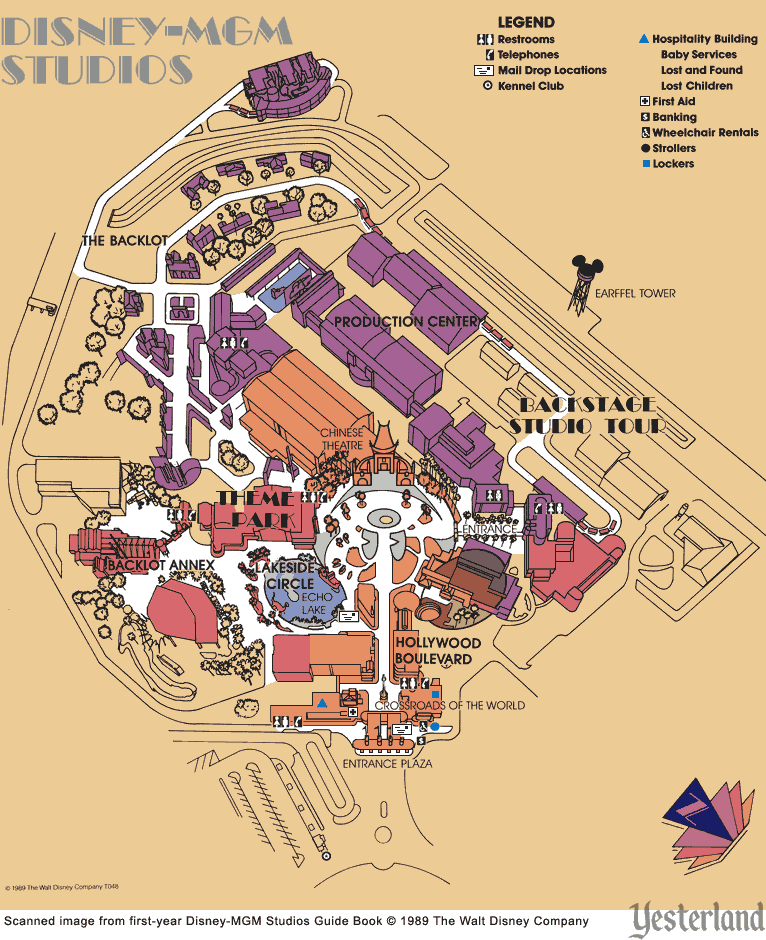
Eisner’s dedication at the park’s opening called on it to be:
…dedicated to Hollywood—not a place on a map, but a state of mind that exists wherever people dream and wonder and imagine, a place where illusion and reality are fused by technological magic. We welcome you to a Hollywood that never was—and always will be.
Perhaps because of the impending threat of the announced Universal Studios Florida, though, the fast-tracked Studios park was relatively underbuilt. Although it had plenty of shows, the park contained very little pedestrian space (just today’s Hollywood Blvd. and Echo Lake) with only one ride: the Lost Legend: The Great Movie Ride – “a spectacular journey into the movies!”

The park’s more overt purpose, at least back then, was to focus on that “place and illusion and reality are fused by technological magic” – a working movie studio. In fact, most of the park’s real estate was initially accessible only via its second ride, the two hour Declassified Disaster: The Backstage Studio Tour – part tram, part walking tour through the studio’s “real, working” production facilities.
Disney historian Jim Hill notes that, from its opening, exit polls showed that guests liked the Studio park, but reported that it needed more things to do – more rides. Though a copy of STAR TOURS was en route to the park for later that year, there was a consensus at Imagineering that the Disney-MGM Studios had left out something important. A hole in the lineup called for something fresh and frightening…
Horror stories
By way of the park’s two rides and many shows, the Disney-MGM Studios included action, adventure, sci-fi, animation, and silver screen classics… but there was one genre the park didn’t celebrate: horror. We don’t need to tell you why: Disney doesn’t do horror. At least, not very well. Disney’s limited attempts at horror-tinged family films hadn’t worked out well, so wven though Eisner’s openness to making Disney Parks cool and thrilling would allow horror a presence in the park, Walt Disney Studios didn’t have a horror movie in its catalogue from which to draw inspiration.
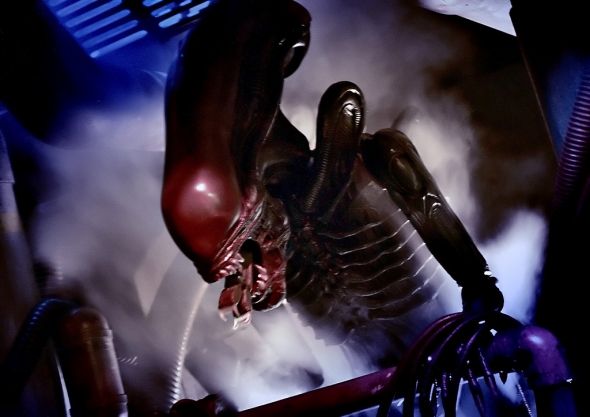
Though Disney had licensed the theme park rights to 20th Century Fox’s Alien, it was in anticipation of the Lost Legend: Alien Encounter, and in the meantime, they’d already featured the Xenomorph creature aboard the Great Movie Ride. So from the moment the Disney-MGM Studios opened, Imagineers were on the hunt for horror properties to bring to the new park. You name it, they looked into it: Friday the 13th, Night of the Living Dead, Texas Chainsaw Massacre, Nightmare on Elm Street. Even, reportedly, a ride to bring all of Stephen King’s horror tales together.
Ultimately, it must’ve been decided that these grisly horror features were too intense for a Disney Park – even a more mature movie-themed one – and Imagineers went back to the drawing board. If no real horror movies would work, maybe they could create their own?
Maybe even a horror-comedy?
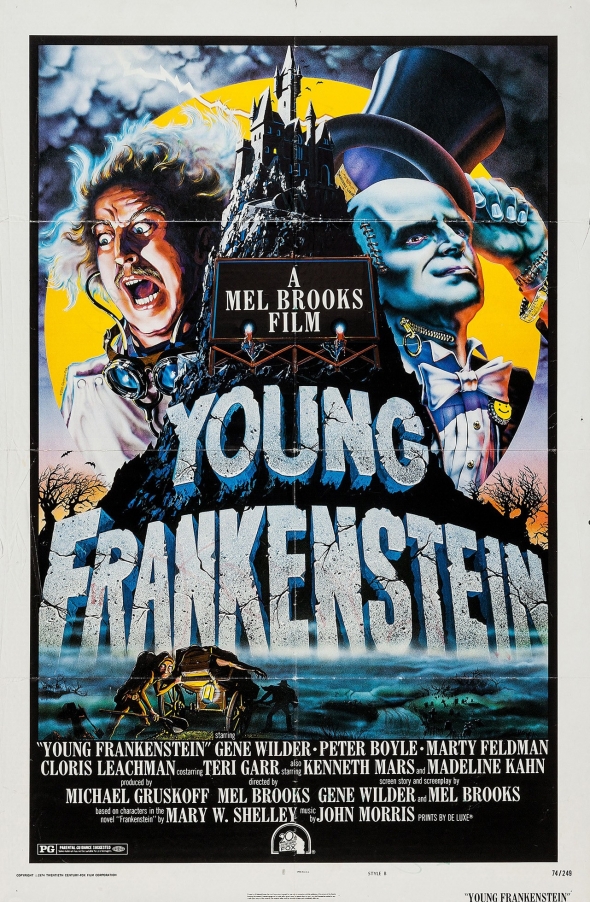
It was at this point that Disney contacted Mel Brooks (brilliant creator of the go-to horror-comedy, 1974’s Young Frankenstein, as well as The Producers, Spaceballs, and Robin Hood: Men in Tights). Like George Lucas, Eisner had carved out a professional relationship with Brooks, and this seemed just the right time to use it.
With Mel, Imagineers created early plans for a dark ride through a haunted Hollywood hotel that was apparently being called Hotel Mel. In line with the Studios’ overarching story, we would’ve been led to believe that we were on a hot set for a movie being shot inside of an abandoned hotel.
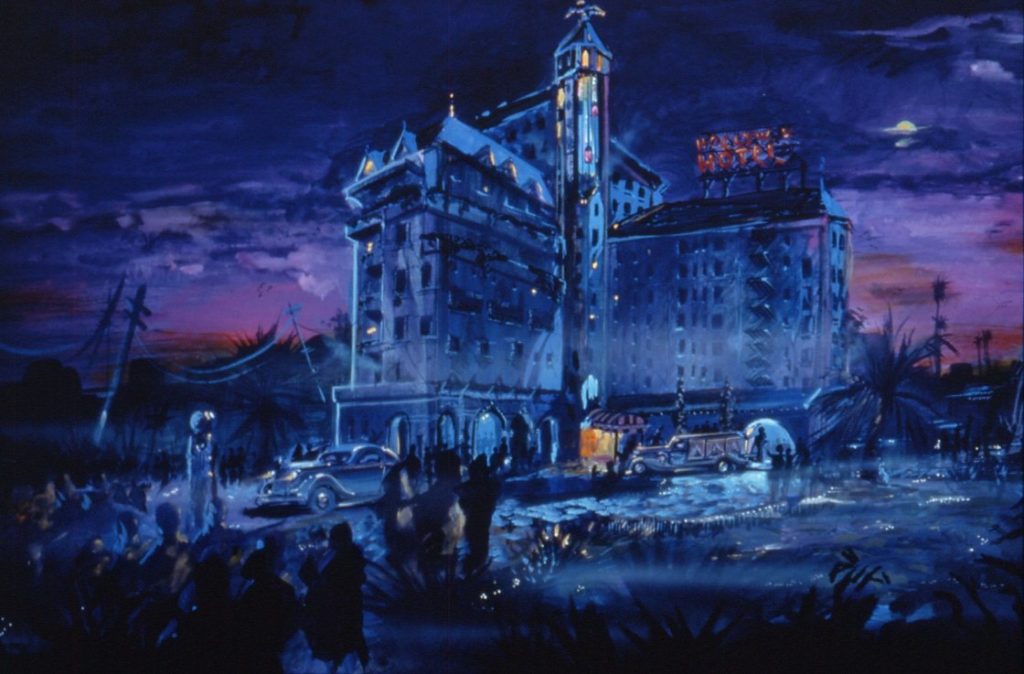
The dark ride, then, would’ve reportedly taken guests behind the scenes to see classic movie monsters at work. Problem is, Imagineers couldn’t get the tone of the ride quite right. Was this hotel really haunted? Where the monsters real, or actors? Were we seeing behind-the-scenes of moviemaking, or were we part of the movie? Were we meant to laugh, or scream?
Point is, Hotel Mel just couldn’t seem to come together in a satisfying way. Not to mention, it didn’t really satisfy Eisner’s decree that Disney Parks should become hip, thrilling places that teens would want to visit. But as Imagineers regrettably left Hotel Mel behind, the idea began to coalesce with that lingering need for a drop ride. Could Disney designers create a triple threat: a thrill ride, horror ride, drop ride?
Coming together
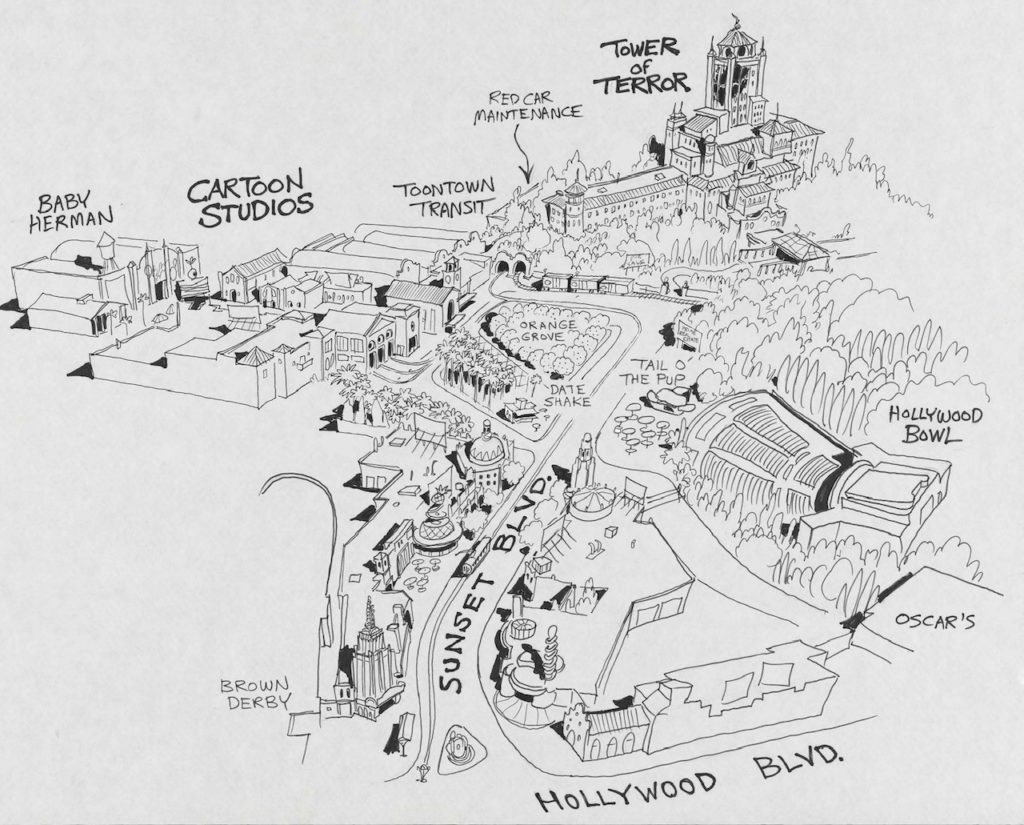
By the end of the park’s first year, “demand” for the Disney-MGM Studios outweighed “supply.” Imagineers needed to open the New York Streets sets (formerly viewed exclusively from the Studio Tour) to foot traffic to add more guest capacity. The Disney-MGM Studios didn’t just need a new headlining ride; it needed a place to put it that would expand the park’s capacity.
Of course, the version of Sunset Blvd. that was initially planned can only be found in our walkthrough of the alternate reality version of the Possibilityland: Disney’s Hollywood Studios with all of its unbuilt attractions in tact… In that version of the park, this 1940s avenue was indeed presided over by a decaying hotel… but not quite the one you might think…
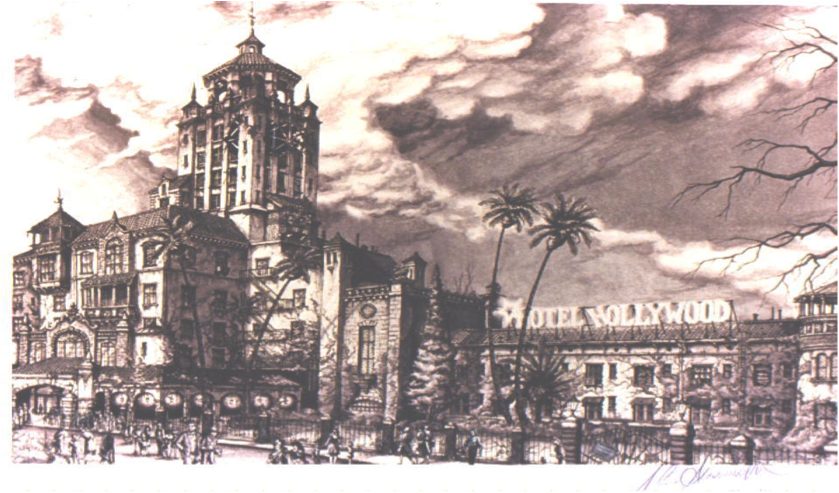
While the idea they’d developed with Mel Brooks hadn’t stuck, by the early ’90s, the idea of a haunted hotel had begun to merge with the back-burnered concept of a drop ride. Sunset Blvd.’s ode to horror and Hollywood at last took the shape of a “Tower of Terror.” Suffice it to say, though, that this “Tower of Terror” still looked a world away from the one we know today, and careful observation of the concept art above will reveal why…
Yes, initial plans for Sunset Blvd. and its “Tower of Terror” used the same Intamin First Generation Freefall drop ride technology that had debuted at Six Flags Magic Mountain nearly a full decade earlier, in 1982. Of course, just as they had planned for Paris, designers would craft a unique “wrap” for the otherwise stark and industrial ride, building the burnt-out husk of the Hotel Hollywood supported by scaffolds and steel.
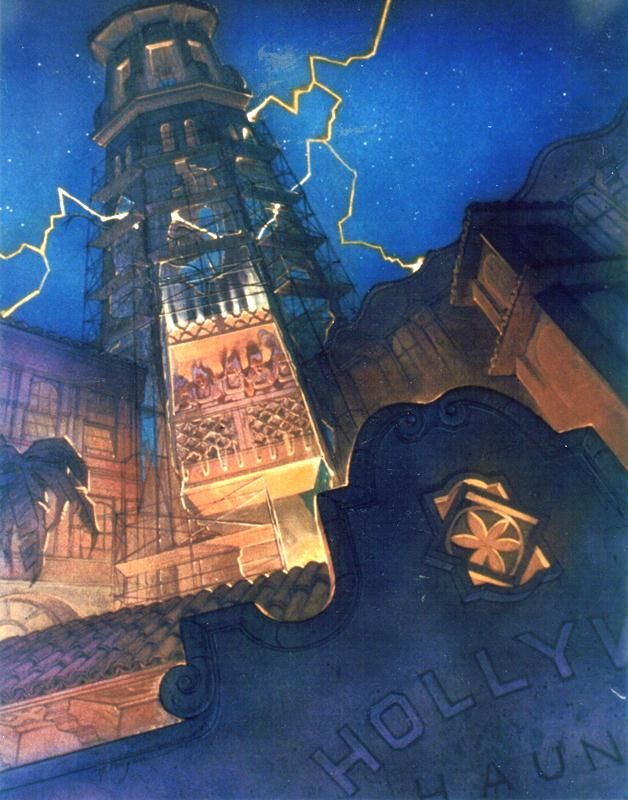
As for the story guests would step into on this version of the ride? According to entertainment writer Jim Hill on the Disney Dish podcast, Imagineers initially envisioned a totally original storyline for this attraction, wherein guests would be stalked by a silent-film-director-turned-madman driven to insanity by the industry’s turn to sound pictures. Four guests at a time would load into the vehicle, where drive tires would advance the elevator backwards and into a lift.
Rising to the peak of the hotel, lightning strikes would briefly illuminate the killer standing atop the elevator cage, laughing maniacally with a pair of scissors poised to snip the cable supporting the ride. Of course, with a roll of thunder and a theatrical snap, guests’ elevators would tear downward through the scaffolding, sliding out in an epic finale.

As the ultra-rare, Member-exclusive concept art above reveals, it was story and setting that Disney supposed would elevate this relatively simple, “off-the-shelf” ride system into far more than a one-and-done experience. Ultimately, Disney didn’t move forward with the first generation freefall tower concept (but someone did in one of the most astounding, must-see Disney “knock-offs” out there today…).
As before, we’re lucky that Imagineers sat on the idea a little longer before deciding on the two key elements that would bring the attraction to life: its content and its technology.
1. Content
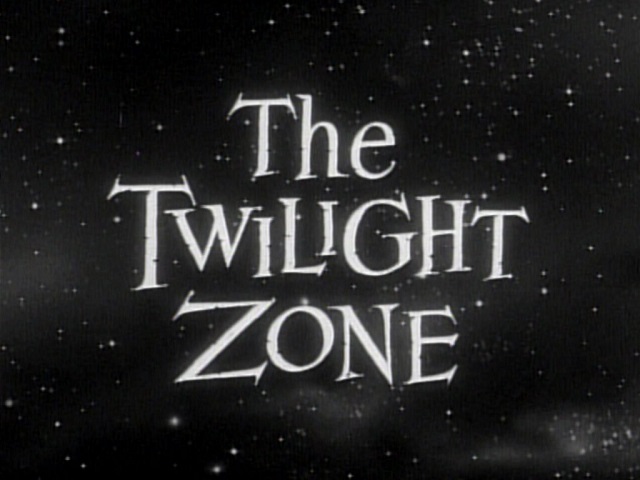
As was a hallmark of his time, Eisner was ready and willing to license an external intellectual property to power Disney’s haunted hotel – to make it eerie, unsettling, and nervewracking. There was no better brand to accomplish it than The Twilight Zone.
The Twilight Zone was a cultural phenomenon forever tied to American pop culture. The five-season, 156 episode series featured a new story, new characters, and new setting in each episode. Sometimes sci-fi, sometimes fantasy, sometimes horror; set in the past, present, or future; always ending with a twist or a moral; the show imagined unthinkable circumstances and surprising endings for everyday people who had unknowingly “crossed over into a land whose boundaries were that of imagination” – The Twilight Zone.
Created, narrated, and hosted by Rod Serling, the creepy, groundbreaking, timeless anthology series had run on CBS from 1959 – 1965 (with a revival from 1985 – 1989) and is widely considered one of the greatest telvision series of all time.
The storied pop program was perfect for a park meant to celebrate cinema. Brilliantly, using the otherworldly, eerie aura of The Twilight Zone allowed Disney to craft a haunted hotel that would give riders good, old-fashioned goose bumps without blood and gore of modern horror while also celebrating a revered, respected, and timeless entry in the cultural canon of in the United States.
2. Technology
They found the answer to their second hurdle – the ride’s technology – in AGVs, or Autonomous Guided Vehicles. The elevators placed within Florida’s Hollywood Tower Hotel weren’t elevators at all. In fact, they’re enormous 22-person ride vehicle carts that merely begin parked in “vertical vehicle conveyance” lift (manufactured by Otis, the company that – ironically – invented the safety elevator in 1853).
But during the course of the ride, those AGVs would live up to their name, advancing out of the life on wheels, moving horizontally – one of the most surprising, technologically clever, and brilliant storytelling elements of any dark ride on Earth. The AGVs would be “trackless,” following a wire embedded in the ground. Then, they would re-enter and lock onto a second high speed “vertical vehicle conveyance” (this one at the front of the building, inside the drop shaft) for their faster-than-gravity freefall at 39 miles per hour.
How does it all come together? Read on as we explore the haunted halls of the Hollywood Tower Hotel and dissect how the ride inside works…



